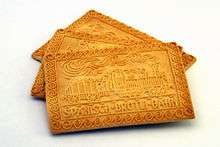Tirggel
|
Industrially manufactured tirggel as sold by Swiss retailer Migros in 2008 | |
| Type | Biscuit |
|---|---|
| Place of origin | Switzerland |
| Region or state | Zürich |
| Main ingredients | Flour, honey, sugar, water |
|
| |
Tirggel are traditional Christmas biscuits from Zürich, Switzerland.[1] Made from flour and honey, they are thin, hard, and sweet.
History
Tirggel-like honey cakes were already popular in antiquity. The earliest known baking moulds for similar pastries date to 3rd millennium BC Mesopotamia.[2] The recipe is believed to have come to northern Europe with the conquests of the Roman Empire.[2] In what is today Switzerland, tirggel are said to have been used as pagan offertory cakes, cut in the shape of sacrificial animals.[3]
Tirggel are first recorded in Zürich as Dirgel in 1461. They have been manufactured there ever since with elaborately carved wooden moulds depicting Biblical or regional themes.[2] More recently, the wooden moulds—four of which are exhibited in the Swiss National Museum—have been replaced by polycarbonate casts, which are easier to handle.[2]
Preparation
Tirggel dough is composed of flour, 29 percent honey,[1] some sugar and water;[4] although one source reports that it is or was made without sugar, which is taken to be an indication of the tirggel's pre-Christian origins.[5]
The dough is pressed very thinly into elaborately carved moulds of varying shapes and sizes; the tirggel can be as large as windowpanes.[3] The biscuits are baked in a high-temperature oven at 400 °C (752 °F) for only 90 seconds[6] and require good timing to get right.[1]
Consumption
Because tirggel are hard and dry, they are best when sucked on for a while, which allows the honey flavour to become more pronounced.[1]
Tirggel are also very durable. Swiss writer Emanuel Stickelberger reported in 1939 that "the tirggel has the admirable quality of not becoming stale, and the harder it gets, the more enjoyable is it to nibble on."[7] On account of their elaborate ornamentation, traditionally manufactured tirggel are often not eaten at all for months or years and are kept as decorations instead.[3]
See also
References
- 1 2 3 4 "Züri Tirggel" (in German). SF Tagesschau. 6 December 2008. Retrieved 2008-12-07.
- 1 2 3 4 Pfändler, Stefanie (3 December 2008). "Wenn es duftet, ist wieder Tirggelzeit" (PDF) (in German). Tages-Anzeiger. Retrieved 2008-12-07.
- 1 2 3 Spicer, Dorothy Gladys (1958). Festivals of Western Europe. Forgotten Books. p. 218. ISBN 1605068012.
- ↑ Baker, Margaret (1992). Discovering Christmas Customs and Folklore: A Guide to Seasonal Rites. Osprey Publishing. p. 35. ISBN 0747801754.
- ↑ Wernecke, Herbert Henry (1959). Christmas Customs Around the World. Westminster John Knox Press. p. 65. ISBN 0664242588.
- ↑ "Tirggel-Herstellung" (in German). Honegger Confiserie Wald. Retrieved 2008-12-07.
- ↑ Stickelberger, Emanuel (1939). Heisst ein Haus zum Schweizerdegen: Tausend Jahre deutschschweizerischen Geisteslebens (in German). II. O. Walter a.-g. p. 688.
Further reading

- Schuh, Gotthard (1941). Tirggel. Ein altes Weihnachtsgebäck. Mit einer Kulturhistorischen Einführung von Edwin Arnet. Amstutz und Herdeg. OCLC 3561897.
- Zogg, Annemarie (1992). Züri-tirggel: Bräuche, Bilder, Herstellung. Zürcher Kantonalbank. OCLC 32194377.
- Ott, Ernst (1967). "Der Tirggel". Schweizer Volkskunde. Schweizerische Gesellschaft für Volkskunde. 57 (1-6). ISSN 0048-9522. OCLC 1765168.
External links
| Wikimedia Commons has media related to Tirggel. |
- Tirggel in the online Culinary Heritage of Switzerland database.
